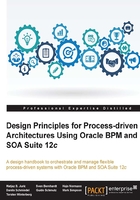
Oracle BPM Suite 12c tackles Game Enterprise BPM
With BPM Suite 12c, Oracle is starting to engage in this domain. The approach Oracle took can be summarized as applying the Pareto principle: 80 percent of the needed features for strategic enterprise modeling can be found in just 20 percent of the functionality of those high-end, enterprise-level modeling tools. So, Oracle implemented these 20 percent of business architecture models:
- Enterprise maps to define the organizational and application context
- Value chains to establish a root for process hierarchies
- The strategy model to depict focus areas and assign technical capabilities and optimization strategies
The following figure represents the new features in Oracle BPM Suite 12c in the context of the Game Enterprise BPM methodology:

Figure 4: Oracle BPM Suite 12c new features in the context of the Game Enterprise BPM methodology
Note
The preceding figure is based on the BPTrends Process Change Methodology introduced in the Business Process Change book by Paul Harmon.
These new features promise to create a link from higher-level process models and other strategic depictions into executable processes. This link could not be established until now since there are too many interface mismatches between enterprise tooling and workflow automation engines.
The new model types in Oracle BPM Suite 12c are, as discussed, a subset of all the features and model types in the EA tools. For this subset, these interface mismatches have been made obsolete: there is a clear trace with no tool disruption from the enterprise map to the value chain and associated KPIs down to the BPMN process that are automated. These features have been there in the EA and BPM tools before. What is new is this undisrupted trace.

Figure 5: Undisrupted trace from the business architecture to executable processes
Note
The preceding figure is based on the BPTrends Process Change Methodology introduced in the Business Process Change book by Paul Harmon.
This holistic set of tools that brings together aspects from modeling time, design time, and runtime makes it more likely to succeed in finally bridging the business/IT gap.

Figure 6: Tighter links from business and strategy to executable software and processes
Today, we do not live in a perfect world. To understand to which extent this gap is closed, it helps to look at how people work. If there is a tool to depict enterprise strategy, end-to-end business processes, business capabilities, and KPIs that are used in daily work and that have the means to navigate to lower-level models, then we have come quite far. The features of Oracle BPM Suite 12c, which are discussed below, are a step in this direction but are not the end of the journey.